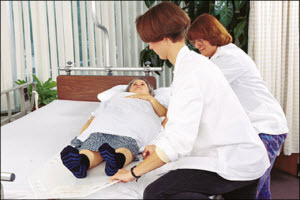
In 2012, U.S. hospitals recorded 250,000 work-related injuries and illnesses. OSHA is fighting back with new resources to protect hospital workers and enhance patient safety. Keep reading to learn more about this initiative.
In announcing the campaign, OSHA chief Dr. David Michaels noted that the resources, including a webpage at http://www.osha.gov/hospitals, will help keep people safe while reducing costs. According to OSHA, work-related injuries and illnesses carry an annual price tag of $2 billion for hospitals.
The agency has targeted hospitals as one of the most dangerous places to work. In terms of lost-time cases, it is more hazardous to work in a hospital than in construction or manufacturing, says OSHA. Hospitals have serious hazards, including lifting, transferring and repositioning patients; violence; and needlesticks, among others. According to OSHA, some caregivers who feel an ethical duty to “do no harm” to patients may sometimes put their own well-being at risk in the course of their jobs.
Most hospital-related injuries result from a few hazards. Nearly half of days-away cases are caused by overexertion or bodily reactions from actions like lifting, bending, or reaching. The link between worker and patient safety is significant. For example, manual patient lifting can injure workers, and it also puts patients at risk of falls and fractures. Caregiver fatigue, injury, and stress are all tied to a higher risk of medication errors and patient infections.
What is OSHA doing to help reduce hospital worker injuries?
OSHA’s new web resources focus on three key areas:
- Understanding the problem. OSHA has produced booklets and a self-assessment questionnaire that provides an opportunity for top administrators to talk with safety managers about injury rates and learn how they affect the hospital’s bottom line.
- Solving the problem by using safety and health management systems. Tools include a guidebook that describes the six core elements of a safety and health management system and strategies for implementing them in a hospital setting. OSHA also provides a table that compares the elements of a safety and health management system with Joint Commission hospital accreditation standards.
- Safe patient handling. Resources include an overview for administrators of the financial benefits of a safe patient handling system, plus profiles of hospitals that have implemented such programs and reduced worker injuries as a result.